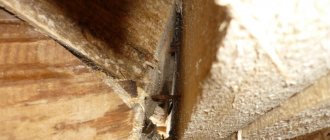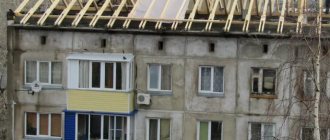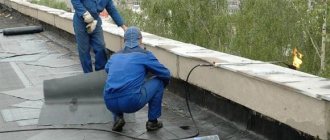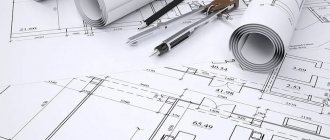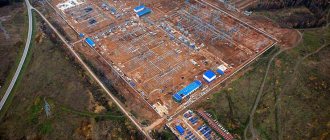Every roof has its own lifespan. Even if it is made of the highest quality and durable materials, copper and slate roofs also need to be repaired periodically. Some things can be fixed as part of routine maintenance, such as replacing cracked shingles or resealing the joint between the roof and the pipe. But when the wear and tear on the roof becomes too much, major roof repairs are necessary. What is included in it, when is it really “time”, and how to carry out repair work correctly - we talk about these and other important subtleties in the article.
Brief overview of roofing rules
Roofs of apartment buildings in Russia can be divided into several types:
● bitumen-polymer;
● metal;
● roofs made of polymer membranes.
Each coating has its own service life; sooner or later it will definitely require repair. How quickly this moment comes depends largely on the service organization. Any roof, like a car, requires mandatory maintenance. Moreover, it does not matter what material the coating is made of.
As part of maintenance, organizations perform the following work as necessary:
- They clean the roof and drainage devices.
When removing debris, protective caps, water inlets and drainpipes should be cleaned with round wire brushes (brush) with a diameter equal to the diameter of the pipe. In internal drainage systems with external outlet, it is necessary to periodically clean the hydraulic valve of the drainage pipe and trays. Do not sweep dust or debris into drains.
- Tighten or replace loose fasteners of edge strips, ebbs, droppers, “skirts” on pipes, parapet coverings and expansion joints.
- Attach caps to pipes, aerators and funnels.
- They replace or repair individual drainage devices, roofing aerators, adapters (rubber and other fittings, cups) and other roofing accessories.
- Restore or replace the sealant in the bend of the edge strip in local places and other elements that require sealing.
- Carry out anti-corrosion treatment of metal roof elements (fence posts, pipes, etc.).
- Repairs minor damage to rolled carpet (holes, tears, peeling, etc.).
- Eliminate other local defects.
Deciding on the Type of Roof Repair
After a comprehensive inspection of the roof, the Customer is offered several options for roof repair with the provision of estimates. The company’s specialists, together with the customer, discuss their proposals, explain the pros, cons and service life of each roof repair option, and together come to the optimal solution. After approval of the final estimate, a contract is concluded for roof repair work, an essential condition of which is the fulfillment of warranty obligations. The main rule of our company is strict compliance with the terms of the contract and achievement of consistently high quality roof repair work.
Carrying out inspections and filling out an operation log
Monitoring the technical condition of the roof should be carried out by conducting scheduled and unscheduled inspections, and their results should be reflected in the “Roof Operation and Repair Log”:
Sample magazine from TECHNONICOL company
The following information is entered into the log: an assessment of the technical condition of the roof and its elements, identified faults, their locations, the reasons that caused these faults, as well as information about the repairs performed. Generalized information about the condition of the roof must be reflected annually in its “Technical Data Sheet”.
Routine inspections are divided into general and partial. During general inspections, the technical condition of the roof as a whole, including the equipment located on the roof, should be monitored. In case of partial – the technical condition of individual elements of the roof structure or equipment. Scheduled inspections are carried out annually:
● in spring – from March to May, at least once;
● in summer – from June to September, at least twice;
● in autumn – from October to November, at least once.
Extraordinary (unscheduled) inspections should be carried out after earthquakes, rainstorms, hurricane winds, heavy snowfalls and other natural phenomena that can cause damage to individual roof elements and engineering systems installed on the roof, as well as when detecting deformations of the roof base and the occurrence of leaks .
The need for timely roof repairs
A reliable roof is an important factor that directly affects the service life of any structure. With a leaking roof, the process of destruction of not only the roof structures, but also other critical structures of the building is sharply accelerated. Therefore, it is extremely important to monitor the condition of the coating and timely repair the roof of the house, preventing the destruction of structures. Timely scheduled preventative repairs of the roof will not cost much, but will extend the total life of the roof by 10 to 15 years.
Carrying out seasonal inspections
It is the responsibility of the operating organization to climb onto the roof twice a year and check the tightness of the most vulnerable areas. Special control is required at junctions, parapets, slats, clamps, funnels, and seams of waterproofing sheets.
All these zones must be installed absolutely hermetically. If a violation is noticed during a visual inspection, it can be eliminated using sealing compounds or by installing a patch, depending on the type of roof.
During spring inspections it is necessary:
● pay attention to the safety of the roofing carpet on the main roof area and the eaves areas on roofs with external drainage;
● remove dirt and other debris from the roof;
● visually check the condition of the protective layer;
● check for bulges in the roof and water saucers;
● violation of the tightness of the junctions of the roofing carpet to protruding structures, engineering equipment, roof exits, junctions to walls, parapets, ventilation pipes, to racks of radio and television antennas, fences, etc.;
● check the condition of drainage devices (valleys, water intake funnels);
● check the presence and correct fastening of protective metal aprons and overhangs, the correct fastening of edge strips and the condition of the sealant.
During spring inspections, you should pay attention to mechanical damage to the roofing carpet, which could occur when clearing the roof of snow with metal shovels. The water resistance of the roofing carpet is also checked by a thorough inspection of the ceilings and walls of the rooms located under the roof.
The obtained data on the appearance of damp spots and leaks should be noted on the plan of the roof or upper floor and the corresponding place of depressurization of the roofing carpet, panel seams and places where walls meet the roofing panels should be determined.
During summer inspections, you should carefully examine the surface of the roof and note the presence of signs of aging of the material: the appearance of cracks, swelling, bubbles over the entire surface, continuous cavities, “spongy” material, loss of protective coating (for roofs made of BPM). Vertical surfaces must be checked for the formation of folds and “sliding” of the material.
Autumn inspections are carried out to prepare the roof for winter: the funnels are cleaned of dirt, and the roof surface is cleared of leaves and debris. However, it is prohibited to sweep them into drains. To clean roofs, wooden shovels, brooms, and polymer scraping devices should be used. In addition, to prepare buildings for winter use, it is necessary to check in the attic:
● insulation of pipelines, air collectors of expansion tanks, ventilation and sewer risers;
● the condition of aeration devices for ventilation of attic spaces and ventilated attic roofs;
● the density of the doors and hatches of the attic spaces and exits to the roof.
The equipment installed on the roof deserves a separate discussion. This often happens in violation of all regulations, especially when it comes to unauthorized installation, for example, of TV antennas, without the permission of the operating organization.
Organization of access to the roof
Access to the roof must be strictly regulated; for this, it is best to keep an appropriate log in which each visit will be recorded. All work on the maintenance and maintenance of roofs is carried out by workers who have permission to work at height, in compliance with safety and labor protection regulations.
Only personnel responsible for the operation of the roof and the equipment located on it should have access to the roof. It is prohibited for personnel to go onto the roof, with the exception of cases of inspections, inspections and minor repairs of the roof, execution of instructions based on the results of technical inspections, installation work, maintenance of engineering equipment, etc.
It is recommended to move on roofing carpet made of polymer membranes (PVC, TPO) along specially equipped protective footpaths. Walking directly on the polymer membrane can damage the roof.
Russian roofs often suffer during snowy winters, when they are cleaned with special effort. It is important to remember that on a flat roof you need to leave a layer of snow of about 5 cm; you cannot use metal shovels, crowbars and axes.
Flat roofs are not cleared of snow. The exceptions are emergency cases, the need for urgent roof repairs and the elimination of possible overloading of load-bearing structures of the roof from snow cover. In this case, measures should be taken to prevent damage to the roof: wooden shovels or scraping devices should be used to clean the roof, and a layer of snow 5–10 cm thick should be left on the roof.
When should it be carried out and within what time frame?
Since we are not talking about emergency repairs, the rest of its types should be carried out as planned in the warm season, during the period when minimal precipitation is expected.
The set of documentation, in addition to the estimate, always includes a work schedule . The repair period depends on the volume of work and cannot be arbitrarily reduced: this period is determined by the amount of labor costs from the estimate documentation.
In order to avoid soaking a large part of the roof area, work should be carried out in accordance with the technological map and the work plan, as well as the work schedule, which takes into account the maximum possible combination of operations and their order. It is the schedule that reflects the duration and duration of the repair, with a specific indication of the start and end dates of the process. However, the duration of work should not exceed the standard.
Clause 4.1 of VSN 58-88(r) establishes that current repairs must be carried out at intervals that make it possible to operate the building normally from the date of commissioning until the start of major repairs.
An approximate list of operations related to routine repairs is listed in Appendix 7 to Rules No. 170.
The management company is obliged to conduct supervision during the operation of a residential building, as well as to eliminate roof leaks and carry out repairs (clause 7 of the Russian Federation Regulations dated 04/03/2013 N 290, clause 4.6.1.1 of Rules N 170).
Even a small damage can lead to big troubles
Even slight damage to the waterproofing layer can have fatal consequences for the roof. Water in the under-roof space will sooner or later cause the insulation to become wet, which means it will cease to perform its main function - to retain heat. Ultimately, this will affect the residents of the building, especially the owners of apartments on the upper floors, since it will become noticeably cooler there.
In addition, the loss of insulation properties inevitably leads to the formation of ice and icicles, and these are serious risks for everyone who finds themselves near the object. In this sense, the short formula for the durability of roofing is as follows: qualified installation, multiplied by regular maintenance activities.
Types of repairs
Depending on the complexity, area and type of damage, as well as on the basis of the defect report, the types of repairs are determined, which can be:
- current. It is carried out in case of minor damage to individual areas of the coating, violation of thermal or sound insulation, or deterioration in appearance. Often it is limited to replacing the roofing sheet in two layers and sealing the seams. Maintains the roof in good condition, requires lower costs in contrast to the second type;
— capital. Complete replacement of roofing material, drainage system, load-bearing structures. At the same time, the wooden elements are treated with antiseptic and fire-fighting agents. This work should only be performed by specialists. During a major overhaul of a flat roof, roofing material is fused to the surface with special burners. Strips of material are laid overlapping and then treated with sealant to prevent leaks. Major repairs require a lot of time and money.
Housing renovation program in Moscow
This is a government program whose task is to improve the quality of life of Russians by demolishing unsafe multi-story buildings and building new ones in the same place. Residents of houses that are subject to demolition will not need to make financial contributions; all previously collected funds will be used for construction. Muscovites will receive new housing in their native or neighboring areas, or they can choose by providing a written agreement. Housing renovation has undeniable advantages, the main one of which is the improvement of living conditions. The construction of new houses will lead to a reduction in the cost of real estate and will make housing affordable. All residential buildings built in the 60s and whose service life exceeded 25 years are subject to demolition, these are:
— multi-section frame houses;
— panel houses on 5 floors;
— experimental residential facilities;
- economy class brick houses.
Demolition of old buildings will be carried out only with the consent of residents. So, if the majority of residents are against it, the building will not be demolished. The disadvantage of the project is that liquidation objects are selected not by the degree of wear or condition, but by region. Simply put, the bill contradicts construction and legislative standards, which require the demolition of emergency buildings that cannot be restored first.
The renovation program involves obtaining new housing with completed repairs. The area of the new apartment will be identical to the area of the old one. If desired, citizens can receive a larger apartment for an additional payment, or monetary compensation. Considering that the state is the guarantor of payments and the issuance of new housing, citizens’ fears are unfounded.
The only condition: the relocation agreement must be signed within two months. Otherwise, the owner loses ownership of the real estate and it is impossible to challenge this even in court.
According to RAPSI research, the project in the capital will cost approximately 2.8 trillion. rubles, only the demolition of dangerous buildings will require about 150 billion. Such costs may cause the freeze of other projects that require cash investments. That is why the feasibility of the renovation program is in question. After all, not only the state, but also citizens will find themselves in a difficult situation. The emergence of new housing will lead to a decrease in the value of real estate on the secondary market, which will deprive owners of the opportunity to sell apartments at a favorable price.
For those residents of the capital who are against the renovation program, the legislation provides for an alternative option. They can carry out major renovations of the building at the expense of residents by hiring a contractor. This option will help preserve your home, although it will require some cash costs.
There is no clear answer about the advantages or disadvantages of the housing renovation program; one thing is immediately clear: it is aimed at improving the appearance of the capital. Therefore, do not rush to pack your things, but rather think carefully about possible options for preserving your own apartment.
Additional elements for apartment buildings
Additional, or shaped roofing elements are metal parts that are necessary to protect the roof from wind, moisture and temperature changes. This is an integral part of the roof structure. When carrying out construction or repair work, special attention must be paid to additional elements, since the reliability and durability of the roofing depends on them. In addition, they perform a decorative function and are installed at joints, bends or slopes. The main shaped elements are:
- skates;
- corners;
- planks;
- low tides, etc.
We will manufacture any element to order according to individual sizes, any complexity and shape. Roofing elements ensure the tightness of the coating around the perimeter of the building. They are made of galvanized sheet steel, which ensures reliability, durability, and eliminates corrosion.
When major repairs are inevitable
If during the inspection it is determined that the degree of wear of the roof is 80% or more, then major repairs are inevitable. Peeling of the waterproofing carpet, numerous damages, leaky connections, accumulation of water in the form of puddles, moisture detected during a test opening of the waterproofing - all these are serious arguments in favor of large-scale reconstruction.
We found similar damage on the roof of one of the residential buildings in Ryazan. The thirty-year-old roof required major repairs. On an area of 860 m², it was necessary to completely replace the waterproofing coating and perform additional insulation.
The roof of an apartment building required major repairs
The worn-out coating did not cope with its functions: the waterproofing did not fit tightly, air bubbles formed in many places, the cornice was torn off, and the connections lost their tightness.
The tightness of the junction was broken
The old insulation, firstly, did not meet the thickness requirements in the region, and secondly, due to leaks, it was almost completely wet:
Thus, the residents of the house suffered from serious heat losses and ice build-up on the eaves.
Let's sum it up
Major roof repairs are an inevitable stage in the existence of any building, unless it is temporary. During the overhaul:
- dismantle the old roofing pie;
- examine and restore or replace load-bearing structures;
- installing a completely new roofing pie.
Due to the large volume of work, major roof repairs can cost even more than installing a roof on a new house.
Overhaul is needed if there is specific damage to the roof: leaks, loose fastenings, bent crossbars or rafters. In addition, if they are performed when the service life of the roofing elements ends: insulation, waterproofing, roofing.
Finding the best solution
The terms of reference for the overhaul included replacement of waterproofing and additional insulation of the roof. The materials chosen were modern insulation boards based on rigid polyisocyanurate foam LOGICPIR coupled with a 1.5 mm thick LOGICROOF V-GR FB PVC membrane.
They decided to fasten the system mechanically. However, before starting work, contractors carried out tests to select a suitable fastener. Looking ahead, it is worth noting: preliminary testing of the selected solutions is the most important stage of a large-scale reconstruction.
The roof of a house in Ryazan had two layers for fastening: a hollow-core covering slab and an old asphalt screed. Contractors opened up the existing system and discovered that in some areas the distance from the top layer to the slab was up to 400mm. This complicated the situation because the correct size fasteners simply did not exist.
The second problem was related to the presence of bulk insulation. This meant that when holes for fastening were perforated, the insulation would instantly fill them. Under newly discovered circumstances, mechanical fastening had to be abandoned.
Checking the asphalt screed finally helped confirm this. It did not meet the requirements for fastener pullout. Thus, in TECHNONICOL standards, the requirement for pulling out an anchor element is 0.9 kN. In this case, this value fluctuated in the range of 0.3–0.4 kN.
Choosing to Innovate
Neither the contractors nor the customers had any doubt that the mechanical fastening system was not suitable in this case. No one could guarantee that the new roof would last for decades. At a meeting with the contractor and representatives of the regional Capital Repair Fund, experts from the manufacturing company suggested considering an adhesive fastening system.
For roofers (as well as for employees of the Capital Repair Fund), this was new. Few people in the housing and communal services system have heard of the adhesive fastening system. In addition, installation required removing about 5–7 cm of old layers. By dismantling the old screed, each square meter of the structure became 50–70 kg lighter.
Naturally, they began to calculate this proposal from an economic point of view. For the work we needed: thermal insulation boards LOGICPIR GLASS FAN, PVC membrane LOGICROOF V-GR FB 1.5 mm, adhesives and specially selected components, including roofing slats, metal disc elements, polyurethane sealant, cleaner for PVC membranes, Logicroof walking path WalkWay Puzzle, PVC aerators.
